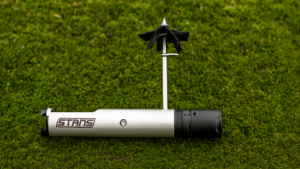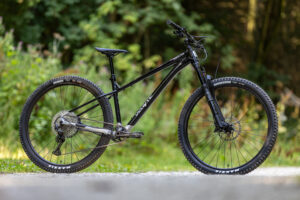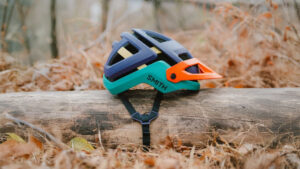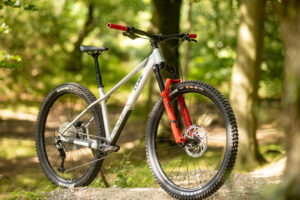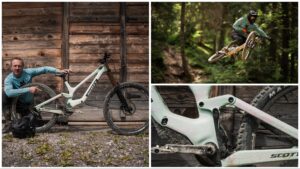Short on travel but big on geometry, we review the best down-country mountain bike rigs – fleet-footed steeds that blend the speed of an XC bike with the capability of trail bike.
Short on travel, light on weight, but big on geometry, the best down-country mountain bike rippers give you everything you want and nothing you don’t. Fast and fun, in a lightweight, efficient package, these bikes can cover ground at warp speed and still be thrashed to within an inch of their lives on proper trails.
Best down-country mountain bikes – quick list
- Best overall down-country bike – Yeti SB120
- Best down-country racer – Specialized Epic 8 Evo
- Best budget down-country bike – Specialized Chisel
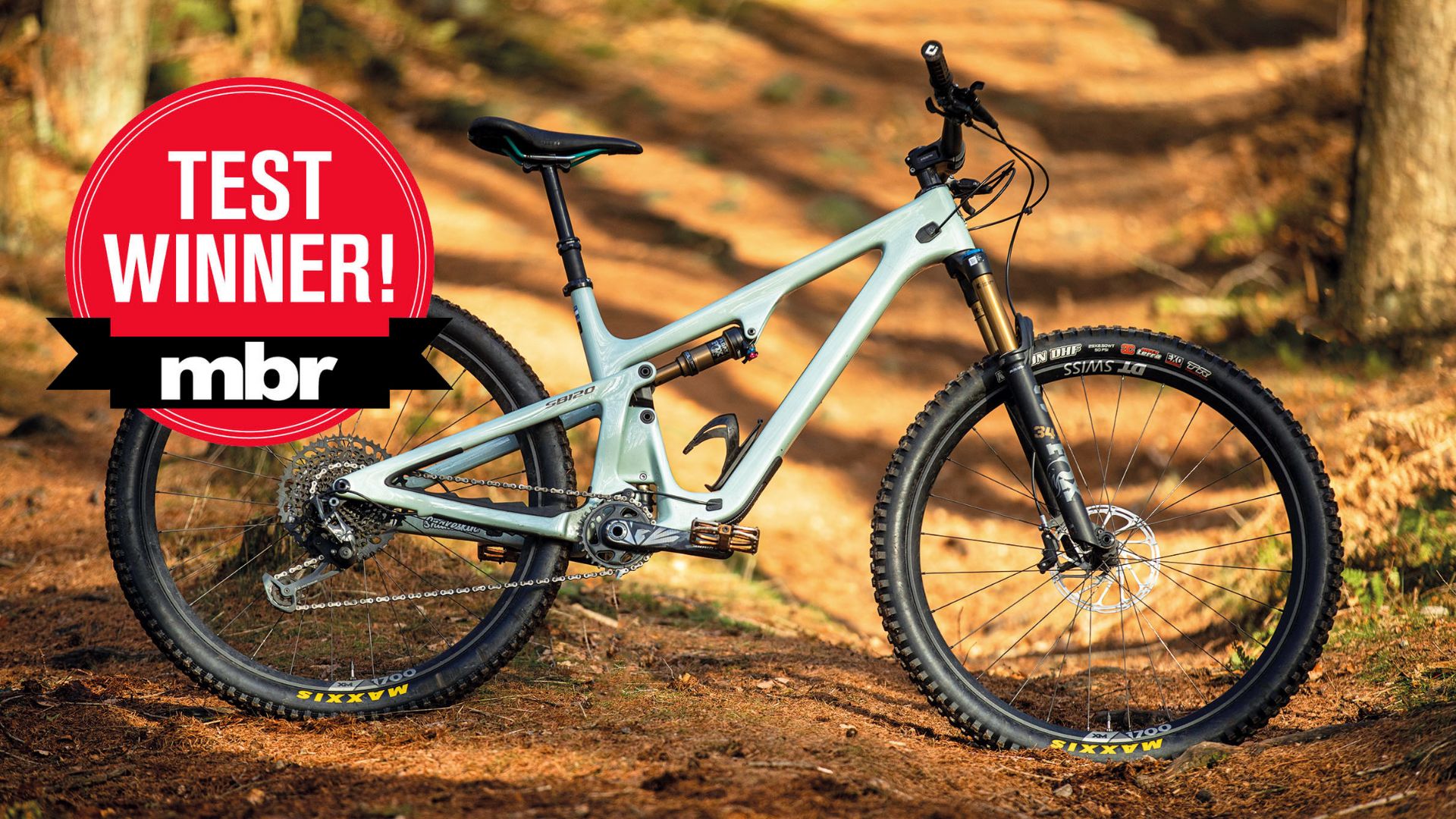
The Yeti SB120 is a down-country bike you can buy with your head as well as your heart.
1. Yeti SB120
The best down-country bike if money is no object
Wheel size: 29in | Frame: Turq carbon, 120mm | Sizes: XS, S, M, L, XL | Weight: 13.3kg (29.3lb) | Rating: 9/10
Reasons to buy:
- All round overachiever with superlative suspension
- Wide size range
Reasons to avoid:
- Agile rather than ultra aggressive
- Not actually that light
- No internal storage
From one of the most aspirational brands in the business comes the impeccable SB120. Yeti shrinks and shoehorns its unique Switch Infinity suspension design into the SB120 chassis. Where the swingarm moves up and down on dual Fox shafts just above the bottom bracket. And the new design has improved seals, bearings, hardware, and pivots, so it should stay in tip-top condition for longer.
And this clever suspension design really works. As we explained in our review, “the supple suspension is stable under power gives a really positive pedalling feel”. Then, when you really hit a something hard and the rear wheel sticks to the ground, giving superb traction and control. It needs a lighter set of wheels to do the flickable geometry and sublime suspension justice, but even out of the box the Yeti SB120 had us smitten.
Read our full review of the Yeti SB120

Specialized Epic 8 Evo
2. Specialized Epic 8 Evo
Best down-country bike for dabbling in a bit of XC racing
Wheel size: 29in | Frame: Carbon, 120mm | Sizes: XS, S, M, L, XL, XXL | Weight: 12.4kg (29.3lb) | Rating: N/A
Reasons to buy:
- Superlight frame for a 120mm trail bike, at 1,870g
- Aggressive geometry that’s ideal for riding hard, and climbing well too
- Components are superlative, with 130mm fork, powerful brakes and sticky front tyre
Reasons to avoid:
- Rear shock tight in feel and doesn’t quite match up with the plush 130mm fork
- Rear tyre clearance isn’t the best
Racing snakes were treated this year to a new Specialized Epic 8, honed and optimised to go from start to finish as fast as humanly possible. But alongside the race bike came a new Epic 8 Evo, designed to replace the position in the Specialized range occupied by the previous Stumpjumper. And it’s proven to be a substitution worthy of any premiership manager, because the new Epic Evo is “properly rally-ready bike with the handling, front end hench and spec to match” according to Guy Kesteven, who rode it at its launch.
Faster and more efficient than either the Tallboy or the SB120, the Epic Evo still clings on to its racing roots, but its hung up the Lycra in favour of a pair of slim-line baggies, and is happy sending terrain that would make all but the world’s best XC racers flinch.
Read our full review of the Specialized Epic 8 Evo

Santa Cruz’s Tallboy is a terrier that thinks it’s a rottweiler
3. Santa Cruz Tallboy
Best down-country bike for sending it
Wheel size: 29in | Frame: Carbon CC, 120mm | Sizes: XS, S, M, L, XL, XXL | Weight: 13.08kg (28.84lb) | Rating: 9/10
Reasons to buy:
- Outstandingly fast and focused full-send aggression
- Does things normally reserved for burlier bikes
- Superb size range
- Internal storage compartment
Reasons to avoid:
- Needs a pretty skilled rider to avoid pratfalls
- Uncomfortably uncooperative on technical off-piste trails
- Can be tiring to ride
Although often overlooked in the comprehensive, verging on confusing, Santa Cruz range, we think the Tallboy is an undiscovered gem. You’ve heard of small man syndrome, or small dog syndrome, well the Tallboy has small bike syndrome, where it steadfastly believes it’s actually an enduro bike, and deserves to be ridden as such. The stiff frame and aggressive angles beg to be wrung out on every descent, yet the efficient suspension and lightweight mean it’s always the first bike back up to the top of the hill.
For some riders, all that straining at the leash might be too much. But if you love wringing the neck of a short travel whip, and seeing your buddies slack-jawed in amazement as you undermine and overtake their big-travel enduro bikes, the Tallboy is the ultimate sleeper bike.
Read our full review of the Santa Cruz Tallboy

Transition’s Spur is still one of the finest down-country bikes we’ve ever tested
4. Transition Spur
Best lightweight down-country bike
Wheel size: 29in | Frame: Carbon, 120mm travel | Sizes: S, M, L, XL | Weight: 11.25kg (24.8lb) | Rating: 10/10
Reasons to buy:
- Perfect blend of speed and control
- Lightweight
Reasons to avoid:
- Not the most robust build if you’re carrying some timber
- Narrow size range
The Transition Spur is arguably the bike that spawned the down-country category, and also the bike that perhaps best defines it. At under 11.5kg, the Spur flies out of the gate, haring up climbs and tearing along high-speed singletrack. That lack of inertia encouraged us to sprint every rise, pop every jump, and schralp every turn, helped by the stable geometry and supple suspension.
With lightweight RockShox Sid forks up front, the temptation is to add travel and girth, but to do so is to dilute the Spur’s potency and add unnecessary grams. So while there’s a bit of flex when pushed hard, we’d treat that as part of the charm, and lap up the whirlwind of action that accompanies every descent. As we said in our review, the Transition Spur is “the best-realised ‘down-country’ bike we’ve ever tested and the one we all covet if we were spending our own cash”.
Read our full test review of the Transition Spur

Specialized’s Chisel has the pace of an Epic without the stratospheric price tag.
5. Specialized Chisel
Best budget down-country bike
Wheel size: 29in | Frame: Alloy, 110mm travel | Sizes: S, M, L, XL | Weight: 11.25kg (24.8lb) | Rating: 9/10
Reasons to buy:
- Genuinely very fast
- Efficient and really well sorted
- Affordable price
Reasons to avoid:
- SX weight and suspension compromises make it worth levelling up to the Chisel Comp if you can
- Not the lightest down-country option
To sit alongside the new Epic 8 and Epic 8 Evo models, Specialized also launched a more affordable option called the Chisel. And despite the down-to-earth price, it gets high-flying performance starting with the techno tour-de-force that is the Chisel’s alloy frame. Hydroformed for swoopy shapes and smartwelded for ultimate strength, the D’Aluisio alloy frame is one of the lightest around.
Geo and suspension travel is like a toned-down Epic 8, but it keeps the pace high with a ride that’s “quick, responsive, and exciting” according to Guy Kesteven, who reviewed it for us. And there’s even a proper Chisel Evo model now, with a longer-travel fork, fatter front tyre, and bigger brakes, to really lean into its down-country talents.
Read our full test review of the Specialized Chisel

Trek Top Fuel 9 gen 4
6. Trek Top Fuel
Explosive trail weapon
Wheel size: 29in | Frame: Carbon or alloy, 120mm travel | Frame sizes: S, M, M/L, L, XL | Weight: 14.67kg | Suspension travel: 130mm f/120mm r | Rating: 8/10
Reasons to buy:
- Superbly enjoyable
- Beautifully balanced
- Intuitively engaging short travel trail bike
- Outstanding rear suspension
Reasons to avoid:
- High price
- It could be even more capable
While the Trek Top Fuel used to be a lean, mean, cross-country fighting machine, the middle-aged spread has left it sagging a little on the scales – even if the latest gen 4 version that Guy tested recently has lost a little weight in development. But don’t let that fact put you off, because the ride quality is worth its weight in gold, even if it won’t be competing for gold medals on the race track.
Trek has chopped down the seat tubes on the new model, helping make it more capable on the down, as well as the country part of its remit. Something that Guy immediately highlighted in the test, in which he raced the Top Fuel at the Ard Rock enduro. “Even in its most trail-biased incarnation to date, there’s an unmistakable velocity vibe to the latest Top Fuel”, he said. The Trek Top Fuel provides a high-octane ride then, that keeps the pace high without compromising on fun. If you can stretch to one of the carbon options, that will help shed some weight, and really light the blue touch paper.
Read our full test review of the Trek Top Fuel 9

The Canyon Neuron 6 is fast and frugal
7. Canyon Neuron 5
Speed freak that also enjoys a party
Wheel size: 27.5in or 29in | Travel: 130mm | Frame sizes: XS, S, M, L, XL | Frame: Aluminium or carbon | Weight: 14.63kg (32.25lb) | Rating: N/A
Reasons to buy:
- Hyper-fast
- Friendly yet rewarding geometry
- Excellent value
Reasons to avoid:
- Seat tube could be a bit shorter
- Saddle is a bit too racy
- Not that light for a down-country bike
The Neuron is Canyon’s back-to-basics trail bike, newly updated for 2023, There are four carbon and four alloy models to choose from, with prices starting from £1,849 for the Neuron 5 and going up to £5,749 for the Neuron CF LTD. There’s also a kids’ Young Hero model with an XS frame and 27.5in wheels for £1,499, and women’s versions of the Neuron 6, Neuron 7 and Neuron CF8 available at no extra cost.
As with the previous bike, all XS and S frames come with 27.5in wheels, while the Medium upwards come with 29in wheels. As with most Canyons, you’ll need to factor in a bike box at £18.99 and delivery at £37.99 to all of the headline prices. Whichever you choose, the latest Neuron is versatile, affordable and a total blast to ride, as happy hitting enduro tracks and sending jumps as racking up the miles on a multi-day ride. The alloy frame has a comfortable, compliant ride that’s never jarring, and the choice of fast-rolling Schwalbe tyres means it rolls along almost effortlessly.
Read our full test review of the Canyon Neuron 6

Looks so sharp you could cut yourself just looking at it: The YT Izzo Uncaged 7
8. YT Izzo
Rapier-sharp speed and agility
Wheel size: 29in | Frame: Carbon, 120mm travel | Frame sizes: S, M, L, XL, XXL | Weight: 11.4kg | Rating: N/A
Reasons to buy:
- Acutely responsive and ruthlessly efficient
- Agile and accurate
- Good spec for the price
Reasons to avoid:
- Nowhere to hide in the rough
- Traction/grip is not the best
- Doesn’t really need the remote lockout
- Front tyre could be more aggressive
YT’s razor-sharp Izzo feels a million miles away from the brand’s signature Capra and popular Jeffsy trail bike. It’s blisteringly fast but ruthlessly unforgiving, so you need to be on top of your game and fighting fit to keep it under control and take the punches. It’s much stiffer than the Transition Spur, and not as capable as the Santa Cruz Tallboy or Yeti SB120, so in some ways it’s a bit of an anomaly. But it’s also a great-looking bike, feels amazing in certain situations, and the fact that it’s a challenge to get the most out of will definitely appeal to a certain type of rider.
Read our full test review of the YT Izzo Uncaged 7

Orange knows how to build a great handling bike, and the Stage Evo is no exception
9. Orange Stage Evo
Packs big bike geometry into a nimble 120mm package
Wheel size: 29in | Frame: 6061-T6 Aluminium, 120mm travel | Frame sizes: S, M, L, XL | Weight: 13.83kg (30.49lb) | Rating: N/A
Reasons to buy:
- Incredibly well-poised handling belies its modest weight
Reasons to avoid:
- It’s arguably a trail bike
Orange may have ploughed its own furrow over the years, towed by a horse rather than a GPS-guided John Deere, but despite the UK-brand’s traditional frame materials and construction methods, it continues to bang out bikes that ride every bit as well as more cutting-edge rivals. Often even better. The Stage Evo is one such bike, and effectively a shrunken Stage trail bike. And from the very first corner we were reminded why Orange still commands a loyal customer base – the Stage Evo simply shreds. When we tested it, we noted “yes, it’s easy to ride beyond the physical limits of the travel, but that’s what makes the Stage Evo such an engaging bike on regular terrain”.
Read our first ride review of Orange Stage Evo

As soon as you release the reins, the Spur starts to gallop
Also worth considering
Of the boutique brands not included here, top of the list must be Pivot with the Mach 4 SL. We rode that at its launch in 2023 and remarked on the remarkable power delivery of the DW-Link suspension, providing propulsion in direct relation to our crank inputs. It also handles confidently, with none of the petulance of a thoroughbred XC rig. Only the sizing seems a little dated compared to the latest releases.
Another Pivot worth considering, but one that didn’t make it onto this list, is the Trail 429. While we enjoyed its comfortable ride and plush suspension, it didn’t feel like the fangs were out far enough to give the scalpel-sharp response that makes a true down-country shredder.

Elbows out for Kesteven on the Scott Spark.
There are a couple of XC bikes that don’t quite make it onto this list, but have some down-country DNA coursing through their bloodstreams. One is the evergreen Scott Spark, with its hidden shock and on-the-fly suspension adjustment. We’ve always admired the Spark’s ability to hammer trails just as hard as it can lap XC courses, and even after nearly four years, it’s still competitive.

Turns in the ferns aboard the BMC Fourstroke 01 LT One.
Equally the Santa Cruz Blur XC doesn’t have the build to chuck down really rough and ragged trails without yielding under pressure, but it’s seriously rapid on smoother trails, both up and down. Also in this vein I should also mention the BMC Fourstroke 01 LT One – essentially the bike Tom Pidcock chose to ride over all-comers before Pinarello made him the Dogma FS. And the BMC seriously impressed us, with raw speed that was addictively fast.

ARC8’s Evolve FS uses a cool linkage design.
The engineers at ARC8 used to work at BMC before starting their own bike brand, so it was perhaps no surprise that the ARC8 Evolve FS boasted a similarly speed-focussed ride with an innovative rail design to guide the shock.
But one bike that missed the target by some way was the Intense Sniper T. Which is hardly surprising since it was adapted to give more travel and suit more demanding terrain. Where stretching the fork and shock upset the geometry, and the dated sizing left us backing down on the descents.
What is a down-country mountain bike?
A few rules to help categorise a down-country bike. The first rule is that these rules are made to be broken!
Nothing over 120mm
No more than 120mm of suspension travel at either end. The archetypal down-country bike should have closer to 100mm of rear travel. And if there’s a 130mm travel fork up front, it’s ruled out. Usually. There are some outliers than we allow into the down-country fold. Otherwise the whole thing just gets far too close to a regular trail bike. So, no Norco Optic or Nukeproof Reactor 290c ST. Too trail-bikey.
Having said that, neither rear travel nor fork travel should have less than 100mm. Save that for XC race bikes.

With less mass to manhandle, down-country bikes like the YT Izzo goad you into throwing shapes at every opportunity.
Nothing steeper than 67°
We’re talking head angles here. Non-XC geometry is the key thing that must be included if a bike is to be classed as down-country. And though we say ‘geometry’ we really mean head angle. There’s currently not much consensus about the other angles and measurements on down-country mountain bikes; they don’t all have longer reach numbers, nor steeper seat angles, nor super low BBs.
But the head angle on all down-country bikes cannot be steeper than 67°. 66° is arguably the most commonly seen number.
Big wheels only
You’ll not find any 27.5in wheels here. Nope, not even just on the rear as a modern mullet setup. 29in wheels rule the down-country roost.

Although it doesn’t have the poppiest suspension feel, the Tallboy is great fun on jump trails
What’s the difference between an XC bike and a down-country bike?
That’s a contentious one, and mostly a matter of opinion. But in our view, a down-country bike is a trail bike with the weight and travel of an XC bike, whereas an XC bike generally has steeper geometry, a lower front end and a stronger bias towards efficiency. Using, for instance, remote lockouts to maximise power transfer on smooth surfaces. The lines are blurred, however, and some XC bikes are closer to down-country bikes than others. And the components used also make defining bikes more difficult. Some down-country forks have all-out XC race forks. Some have middling 34-35mm stanchions. Some have four-pot brakes and huge rotors. Others just have 180/160 twin-pot combos. Some have dinky stems. Some still sport stems over 50mm long.

True XC bikes, like the Specialized S-Works Epic WC, are lighter, pricier, and more focussed machines.
It’s the finishing kit that is perhaps key to the down-country experience. And expectation. Some down-country bikes appear to be aimed at ex-XC lycra-heads looking for more fun and less sketch in their rides. Other down-country bikes are aimed at the all-out aggro brigade who have tired of their super-capable enduro bikes and wish to inject a level of limit to their Sunday shredding.
In our opinion, it’s the latter type of down-country bike that is most interesting and exciting. But more capable XC bikes also provide unique thrills, and that injection of effortless pace never gets boring.
Slacker, longer, lower… shorter. Bring it on.










